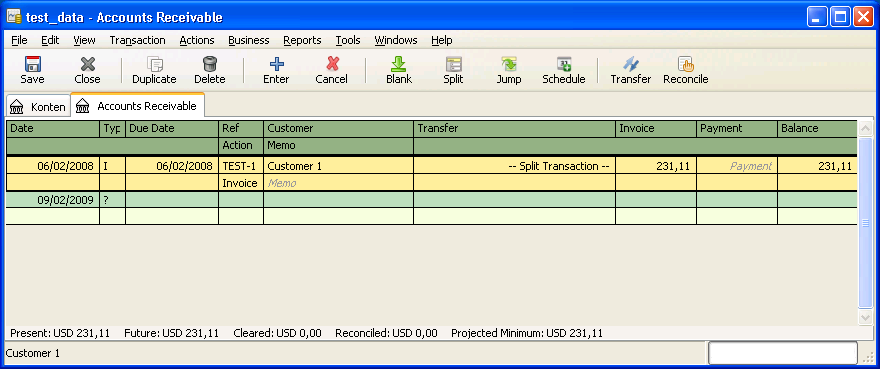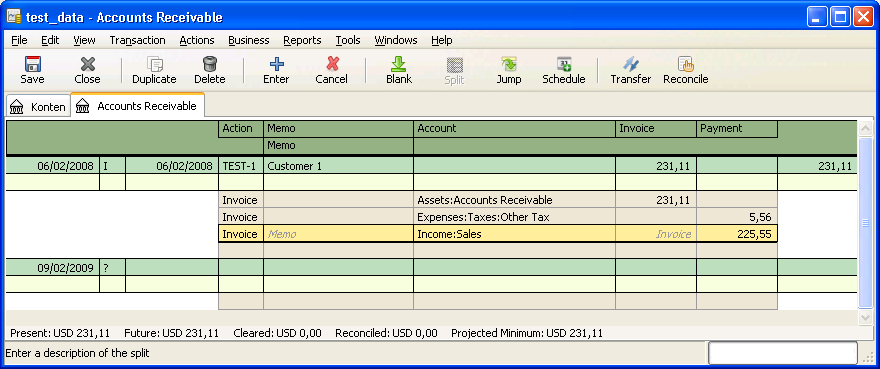Specifications General Ledger: Difference between revisions
Jump to navigation
Jump to search
| Line 15: | Line 15: | ||
=== double entry bookkeeping === | === double entry bookkeeping === | ||
* see also http://en.wikipedia.org/wiki/Double-entry_bookkeeping_system | * see also http://en.wikipedia.org/wiki/Double-entry_bookkeeping_system | ||
==== Transactions in GnuCash ==== | ==== Transactions in GnuCash ==== | ||
* see [http://www.gnucash.org/docs/v1.8/C/gnucash-guide/basics_entry1.html] | |||
** "For every transaction, total debits must equal total credits." | |||
* see [http://svn.gnucash.org/docs/help/trans-multi-enter.html GnuCash Manual: Multiple Split Transactions]; also see a discussion here: [http://www.mail-archive.com/gnucash-devel@gnucash.org/msg22004.html]; | * see [http://svn.gnucash.org/docs/help/trans-multi-enter.html GnuCash Manual: Multiple Split Transactions]; also see a discussion here: [http://www.mail-archive.com/gnucash-devel@gnucash.org/msg22004.html]; | ||
** there are simple transactions (one split), which just post to 2 accounts, with same (opposite) amount, same narrative etc | ** there are simple transactions (one split), which just post to 2 accounts, with same (opposite) amount, same narrative etc | ||
| Line 34: | Line 29: | ||
The other View is: Transaction Journal, this shows all movements of money involved: | The other View is: Transaction Journal, this shows all movements of money involved: | ||
[[image:GnuCashTransactionViewTransactionJournal.png]] | [[image:GnuCashTransactionViewTransactionJournal.png]] | ||
==== Transactions in Petra 2.x ==== | |||
* the definition of transaction in Petra 2.x is different from anyone else's definition: In Petra 2.x, a transaction only involves one account, therefore you need at least 2 transactions to get to "total debits equal total credits". | |||
* in Petra 2.x: a lot of transactions are in one journal, only some of them really belong together ("total debits equal total credits"). | |||
* a journal was only used for different grouping transactions by currency | |||
* it was hard to find all parts of a real transaction, because there were so many transactions in the journal unrelated to each other | |||
==== Transactions in OpenPetra ==== | |||
* option 1: do the same as GnuCash: | |||
**keep the same database structure as in Petra 2.x, with a_batch/a_journal/a_transactions | |||
**different GUI: journals are not displayed anymore as such, but they become the transactions to the user; you can expand a journal line and see/edit the transactions involved. | |||
**simple transaction involves 2 accounts | |||
*** only one reference/narrative/amount | |||
** split transaction: allows to define each account/reference/narrative | |||
* option 2: keep the Petra 2.x users happy | |||
** addition in the database: a_transaction.a_transaction_group_i: refers to one transaction in the group; all transactions with the same a_transaction_group_i make up a real bookkeeping transaction | |||
** GUI: mark several transactions in the grid, and click button "Group", which will assign the first transaction_number_i to all transaction_group_i in the group. | |||
* improved reports will show the opposite transaction(s), on Account Detail report etc. | |||
=== Posting === | === Posting === | ||
Revision as of 07:45, 2 September 2009
multiple currencies
- There is a base currency for each ledger, the balances of the ledger are stored in the base currency
- There is an international currency
- it is only used for reporting (previously it was stored with each balance, but that caused too much problems/overhead)
- There can be foreign currency accounts which have balances in their own currency
- they can be revaluated with a new daily exchange rate
- exchange rate is stored in the database
- corporate exchange rate (eg. issued once per month, an average exchange rate over the last 30 days)
- the corporate exchange rate is used for calculating the reports in international currency
- it is also used by ICH for clearing the debits/credits of the different offices between each other
- daily exchange rate: this can be updated each day, or downloaded from Yahoo Finance etc.
- the daily exchange rate is used for transactions with other currencies (different from base currency)
- corporate exchange rate (eg. issued once per month, an average exchange rate over the last 30 days)
transactions
double entry bookkeeping
Transactions in GnuCash
- see [1]
- "For every transaction, total debits must equal total credits."
- see GnuCash Manual: Multiple Split Transactions; also see a discussion here: [2];
- there are simple transactions (one split), which just post to 2 accounts, with same (opposite) amount, same narrative etc
- there are multiple split transactions, that have several transactions, and combined they balance
- see the GUI of GnuCash for this:
You can switch between View: Basic Ledger, this shows only the summary:

The other View is: Transaction Journal, this shows all movements of money involved:

Transactions in Petra 2.x
- the definition of transaction in Petra 2.x is different from anyone else's definition: In Petra 2.x, a transaction only involves one account, therefore you need at least 2 transactions to get to "total debits equal total credits".
- in Petra 2.x: a lot of transactions are in one journal, only some of them really belong together ("total debits equal total credits").
- a journal was only used for different grouping transactions by currency
- it was hard to find all parts of a real transaction, because there were so many transactions in the journal unrelated to each other
Transactions in OpenPetra
- option 1: do the same as GnuCash:
- keep the same database structure as in Petra 2.x, with a_batch/a_journal/a_transactions
- different GUI: journals are not displayed anymore as such, but they become the transactions to the user; you can expand a journal line and see/edit the transactions involved.
- simple transaction involves 2 accounts
- only one reference/narrative/amount
- split transaction: allows to define each account/reference/narrative
- option 2: keep the Petra 2.x users happy
- addition in the database: a_transaction.a_transaction_group_i: refers to one transaction in the group; all transactions with the same a_transaction_group_i make up a real bookkeeping transaction
- GUI: mark several transactions in the grid, and click button "Group", which will assign the first transaction_number_i to all transaction_group_i in the group.
- improved reports will show the opposite transaction(s), on Account Detail report etc.
Posting
- posting: should show a preview of how the account balances would be after posting???
reduce number of tables
- to test: should there be 3 different tables, for transactions from the current periods, the closed periods of the current year, and periods of previous years?
- is Postgresql fast enough to cope with all transactions in one table?
- this would make reporting much easier